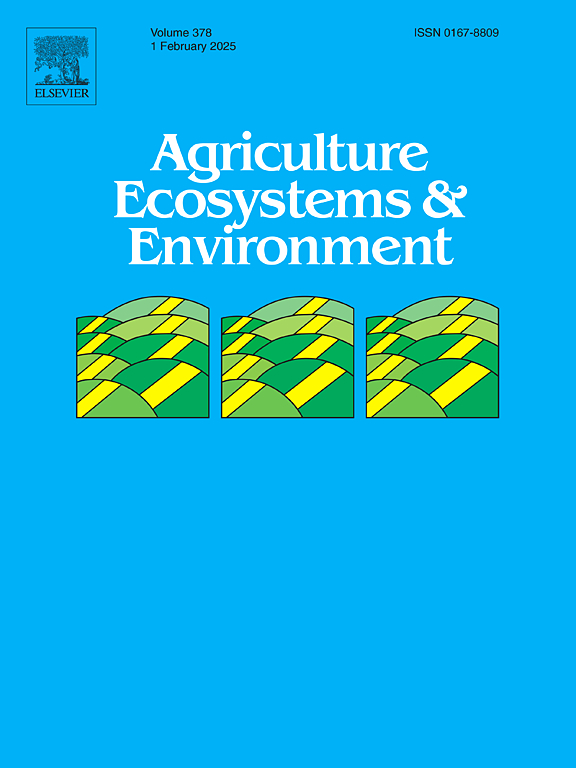超越边界:保护区在促进马达加斯加农村地区蝙蝠介导的虫害防治方面的作用
IF 6
1区 农林科学
Q1 AGRICULTURE, MULTIDISCIPLINARY
引用次数: 0
摘要
保护区可以通过支持减轻农村农业社区面临的主要挑战的生态系统服务,在提高农业可持续性方面发挥关键作用。在马达加斯加,自给农业是森林砍伐和生物多样性丧失的主要驱动因素,与病虫害有关的农业和收成损失使情况进一步恶化。众所周知,食虫蝙蝠是农业害虫的天敌,但保护区在保护周围农村景观中的这一服务方面的作用尚不清楚。这项研究调查了栖息在马达加斯加北部保护区内的食虫蝙蝠所带来的好处,重点是它们抑制农业害虫和疾病媒介的潜力。我们利用分子技术分析了来自不同种类和地点的蝙蝠的粪便样本。我们发现,大多数蝙蝠物种消耗影响水稻和其他作物的节肢动物害虫,以及一些导致人类和动物疾病的病原体载体,如疟原虫的蚊子载体。考虑到它们的流动性和家庭范围,我们认为某些栖息在保护区的蝙蝠物种具有在附近农业景观中觅食的扩散能力,有助于抑制害虫和降低疾病风险。因此,保护保护区内及其周围的蝙蝠栖息地可能是提高农业生产力和公共卫生的一种具有成本效益的手段。这些发现强调需要将生态系统服务纳入保护和土地利用管理战略,促进马达加斯加的可持续性和农村福利。本文章由计算机程序翻译,如有差异,请以英文原文为准。
Beyond borders: The role of protected areas in promoting bat-mediated pest suppression in rural areas of Madagascar
Protected areas can play a crucial role in enhancing agricultural sustainability by supporting ecosystem services that mitigate key challenges faced by rural farming communities. In Madagascar, subsistence agriculture is a major driver of deforestation and biodiversity loss, worsened by pest-related agricultural and harvest losses. Insectivorous bats are widely known natural enemies of agricultural pests, but the role of protected areas in safeguarding this service in surrounding rural landscapes is unclear. This study investigates the benefits provided by insectivorous bats roosting within protected areas of northern Madagascar, focusing on their potential to suppress agricultural pests and disease vectors. We used molecular techniques to analyse the diet of bats based on faecal samples from several species and locations. We found that most bat species consumed arthropod pests affecting rice and other crops, as well as several vectors of pathogens that cause diseases in humans and animals, such as mosquito vectors of Plasmodium sp. Given their mobility and home ranges, we suggest that certain bat species roosting in protected areas have the dispersal capacity to forage in nearby agricultural landscapes, contributing to pest suppression and disease risk reduction. Hence, protecting bat roosts within and around protected areas may offer a cost-effective means to enhance agricultural productivity and public health. These findings underscore the need to integrate ecosystem services into conservation and land-use management strategies, fostering sustainability and rural welfare in Madagascar.
求助全文
通过发布文献求助,成功后即可免费获取论文全文。
去求助
来源期刊

Agriculture, Ecosystems & Environment
环境科学-环境科学
CiteScore
11.70
自引率
9.10%
发文量
392
审稿时长
26 days
期刊介绍:
Agriculture, Ecosystems and Environment publishes scientific articles dealing with the interface between agroecosystems and the natural environment, specifically how agriculture influences the environment and how changes in that environment impact agroecosystems. Preference is given to papers from experimental and observational research at the field, system or landscape level, from studies that enhance our understanding of processes using data-based biophysical modelling, and papers that bridge scientific disciplines and integrate knowledge. All papers should be placed in an international or wide comparative context.
 求助内容:
求助内容: 应助结果提醒方式:
应助结果提醒方式:


